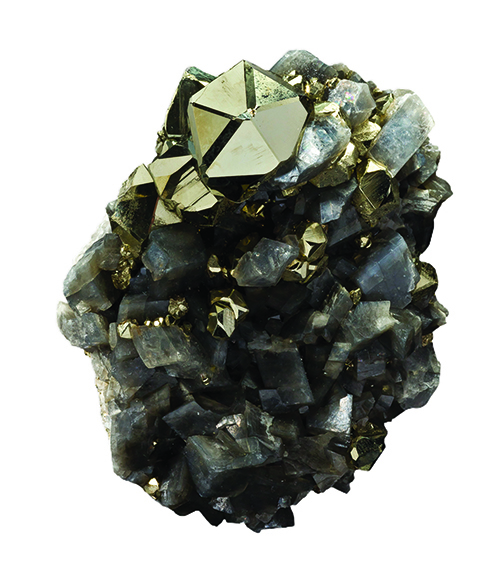
Pyrite appears in over a half dozen different forms, from simple cubes to complex twinned dodecahedrons, and is found in countless deposits all over the world. Pyrite is so varied and common, any collector could devote an entire collecting career to this one species.
Chemically pyrite is not complicated. One molecule of pyrite is composed of one atom of iron and two atoms of sulfur, iron disulfide. What is complex about pyrite is the many crystal forms it can take and still remain in the isometric or cubic crystal system!
Pyrite Forms
Some pyrite crystals differ enough to be given odd names like iron cross and oscillating cubes, pyrite suns, pyrite bars and pyritized fossils. Yet cubic pyrite’s most common and very recognizable crystal form is pyritohedron. Instead of having a square crystal face of a cube as you would expect, pyritohedron faces are five-sided. Luckily today, thanks to one important deposit in Spain, the most common form for pyrite available is simply a cube on a white marl matrix.
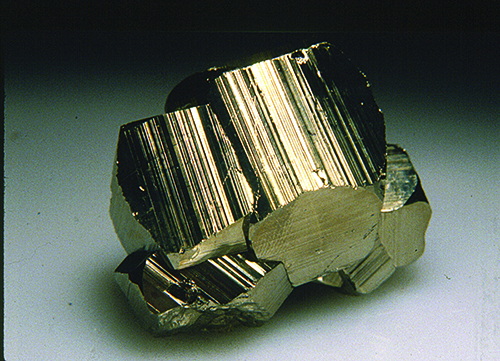
Common Pyrite Cubes
Many of the pyrite cubes you see on the market today are from the Ampliación a Victoria mine, Navajun, Spain, where pyrite crystals are the only ore. Typically pyrite is almost always found as a by-product during mining for other minerals. But this Spanish mine is unique in that it is worked exclusively for pyrite crystals.
It produces simple cubes found in an amazing range of sizes — from a fraction of an inch on an edge to as much as six or more inches. Specimens for sale may have just one sharp, lustrous cube on the gray-white marl matrix. Or, you may see specimen clusters of a dozen or more stacked pyrite cubes of varying sizes attached to and penetrating each other at odd but pleasing angles. The cubes are always lustrous with mirror-smooth reflective faces, sharp edges, and unblemished. They do not look like that when mined. Though pyrite is the most common sulfide mineral in the earth’s crust, a deposit of just pyrite crystals is exceptional.
History of Navajun, Spain Deposit
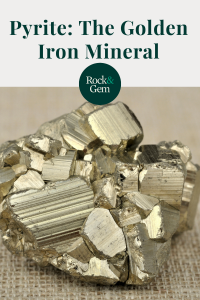
The deposit at Navajun, Spain, has a long history. The Romans mined these cubes and used them in artwork by embedding them in tile mosaics. It’s hard to believe the very tiny cubes were believed to have some medicinal value, and people would swallow the little crystals whole! Imagine how that would feel if the crystals did not dissolve.
The Spanish cubes are loosely embedded in the marl, consisting of a mixture of clay and calcium carbonate. The deposit formed 350 million years ago in what was mostly a freshwater deposit. The mud environment was rich in iron with some form of algae in the mud, which broke down the organic material releasing sulfur. Water descending through the mud picked up the iron and sulfur, which combined to form pyrite cubes in the soft matrix. This quiet environment allowed crystals to grow in size throughout the deposit. And therein is a problem.
As the mud solidified into marl, the pyrite cubes could only attach loosely to the rock because the cubes’ surfaces developed a thin oxidation and calcium carbonate layer. Reports by collectors tell us when cubes are encountered they are not firmly attached to the marl because of the tarnish as a light rusty coating that hinders cube-rock attachment. Specimens have to be worked on before marketing, a legitimate method for preparing specimens for sale.
Mining Spanish Cubic Pyrite
During mining, cubes are carefully collected together with the matrix, cleaned, and reattached to their proper place on the matrix and to each other. This process is common practice at places like Herkimer with quartz clusters, fractured pegmatite gem crystals, etc. The final results of preparation work at the Victoria mine are absolutely stunning and eye appealing, just as nature intended.
Spanish cubic pyrite is not the only unusual pyrites on the market that have to be cleaned, trimmed, and preserved after being brought to grass. The pyrite suns in the coal mines of Illinois also need attention after mining.
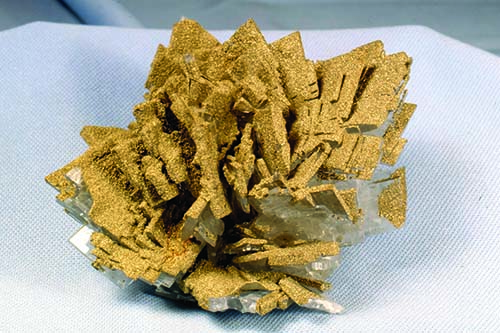
Captivated by Pyrite Suns
You have undoubtedly seen these flat thin, disc-like pyrite suns with an odd radiating surface pattern that is so symmetrical it looks organic. Pyrite suns are not organic, though they were often thought to be fossil sand dollars. Pyrite suns formed far from the beach sands deep underground some 300 million years ago during the Carboniferous Age when the formation of coal seams developed in Southern Illinois around Sparta.
The anthracite coal beds around Sparta are just about played out now, in part because the coal is sulfurous, which is released when the coal was burned. During mining here, odd pyrite discs, eventually called pyrite suns, discs, dollars, you name it, were found in the thin open seams of the coal beds. Pyrite suns are crystallized specimens of pyrite that developed from the iron and sulfur in the coal deposits. As crystals developed, growth was restricted to the very thin spaces between sub-parallel layers of coal.
Composition Formation
Coal forms from the rotting vegetation of earlier plant life in a huge swamp area. Slowly the plant life died, was buried and compressed until all that was left of the plant matter was the plant carbon and related chemicals like hydrogen sulfide, the by-product of bacteria in the watery mix. The iron and sulfur in this chemical mix combined to form the pyrite crystals. The problem is the space where the pyrite crystals form restricts growth in a two-dimension space, so crystal growth is limited to forming long radiating crystals that just fit the space available and grew in four directions instead of six.
As coal developed during its composition from plant matter, any remaining sulfur and iron could cause other minerals like marcasite to grow. Sulfur itself might also be trapped in the pyrite disc, which is fine until the discs are brought to grass, and the owner decides to clean the mineral.
The discs have to be stabilized and kept completely dry to ensure the sulfur is removed. Any marcasite will start decomposing when wet, which is another serious problem. Some pyrite dollars contain the second iron-sulfur mineral marcasite, which is an iron disulfide in the less stable orthorhombic crystal system, which is why it is negatively affected by water.
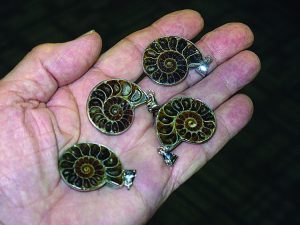
Pyrite Bars
Yet another odd pyrite form is natural pyrite bars. These odd crystal clusters were found during mining along the Viburnum Trend in Central Missouri. The mines produced quantities of fine collector specimens of galena, calcite, sphalerite, and other sulfides.
One mine in particular in the Trend, the Buick, produced really unusual crystallized pyrite in long, square bars that looked like stacked cubes with a myriad of facial growths along all four prism faces. The bars range in length from an inch or so up to twelve to fifteen inches long. In a cross-section, they measure an inch or more in width. The exposed end surface of a broken face of a bar reveals an interesting star-like crystal pattern.
The small bars appeared straight, but the longer bars are slightly curved and show a gradual twist as if made of offset cubes. The side prism faces are not smooth but heavily patterned with growth features that are quite unusual and often sparkle nicely. Some bars I’ve seen that came to grass decades ago have lost luster, but originally the bars were brassy looking.
Aside from these odd forms and the normal cube form, pyrite has a nice selection of a half dozen crystal patterns in the cubic system. The octahedron form is often seen, and single crystals look like a double pyramid, often slightly modified with cube faces along the edges. The most popular crystal form and easiest to recognize is the basic dodecahedron modified with five-sided faces.
Enamored by Oscillatory
My favorite crystal form for pyrite is a mix of two forms, octahedron and the cube called oscillatory growth. This happens when the environment of crystal formation is varied during crystal growth. It happens that the crystal can’t decide if it wants to be a cube or an octahedron and will develop alternating narrow faces, resulting in deep rounded grooves on the prism faces as growth switches back and forth between the two forms. Striations in these crystals differ from the normal striations seen on pyrites. The grooves are deeper and slightly rounded due to the growth patterns.
Cathedral Pyrite
One of the rare forms of pyrite is called cathedral pyrite and is found in the Leadville silver mines. The cube faces have prism growths shaped like the curving pointed windows of a Gothic cathedral. Note, too, that some of the pyrite crystals from Leadville, Colorado, contain bits of gold in them.
For serious pyrite collectors, there are other forms the iron disulfide can take. It often develops in long wire-like tangled growths. It has also been mined as perfect spherical balls of pyrite with thin horizontal rows of tiny crystals completely encircling the sphere. These have started appearing from China.
Unusual Pyrite Forms
Another unusual occurrence for pyrite happened during the expansion and construction of the Dallas-Fort Worth airport. During excavations for runways, an area was opened and appeared to be loaded with small flat discs of small pyrite crystals, although, unlike pyrite suns. These consisted of tiny, flat pyrite crystal groups bulging in the middle. Many specimens also had lightly brighter, larger cubes of pyrite around the perimeter of the crystal clusters. Other clusters took the shape of small animals. Local collectors had a ball sneaking onto the airport construction site at night to find pyrite crystals.
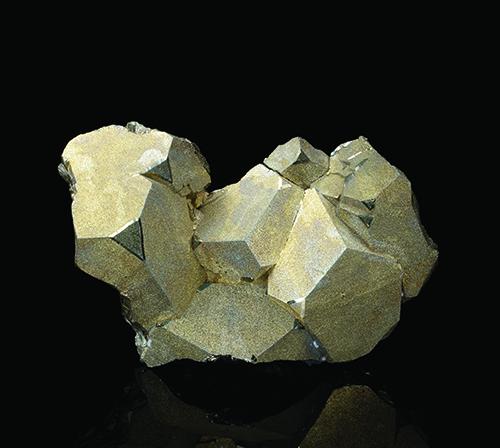
Pyritized Fossils
Though you may not collect fossils, you might consider collecting pyritized fossils. As ancient life with hard shells died, their hard coatings may be replaced by pyrite since the bacteria present may provide sulfur to any iron readily available in sediments on the earth and ocean floor.
There is a broad range of ancient life that has been found pyritized. Pyritized fossil ammonites, trilobites, brachiopods, pelecypods, snails and all sorts of ancient sea creatures have been found replaced by fool’s gold. Folks in the Ohio area are particularly lucky to collect these brassy fossils, many of which are polished to show a bright golden color. Such fossils are found in many other places, including Germany, Russia and China.
Other Pyrite Sources
Another interesting source for odd pyrite in Ohio is in some of the limestone quarries. Odd snake-like pyrite growths, often very fragile, have been collected.
Once you start collecting pyrite, there is no end in sight. As the most common sulfide mineral found worldwide, there is such a great variety of forms with the potential of more to come suggests there is no end of specimens coming to grass. The broad array of crystal forms this mineral is capable of forming will keep any collector busy. Pyrite is a very worthy collector specimen.
This story about pyrite previously appeared in Rock & Gem magazine. Click here to subscribe. Story by Bob Jones.















